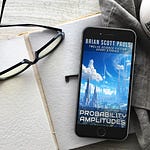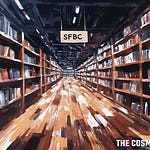My latest short story An Unexpected Grace appears in Boundary Shock Quarterly 24: Science Fiction Holidays.
Still coming to terms with her decisions during a recent assignment, Corporal Siwela takes a leave-of-absence. Perhaps a holiday visit to her home community will help get her head straight. But the trip doesn’t go as planned. Marooned and wounded in the Martian outback, running out of air, Siwela won’t survive without aid. This wasn’t how she planned to spend Christmas.
Princess Serina, the last survivor of House Starfire, refuses to be crowned empress until she’s wiped out the rebels who killed her family. Only then will she prove to the bickering nobility, and herself, that she is worthy of the crown.
Just when victory seems near, mysterious messages lead her to believe the rebels have infiltrated the Core’s military. Her investigations reveal a new threat, one even more insidious than the assassination of the emperor sixteen years before. Will she unmask the conspiracy that threatens to destroy everything she sacrificed to protect? Or will she become its next victim?
On the Outward Edge is the first book in a series of five novellas capturing the critical moments of the fourth era, the Core Galactic Empire, in the Myriadu universe
Club Codex is reading and discussing the Locus Award-winning novel “The Mountain in the Sea” by Ray Nayler through December 16. Please join us!
by Brian Scott Pauls, written using ChatGPT 3.5
The Marvel Cinematic Universe. The Flash. Everything, Everywhere, All at Once. The multiverse now rules the movies.
Science fiction readers know the idea’s been around far longer.
Consider these examples:
Sidewise in Time by Murray Leinster
In this 1934 story, sections from alternate Earths replace regions of our own world. A professor and several students get caught up in these chaotic changes. Their environment becomes a patchwork of different time periods. Neighboring zones belong to historical eras separated by years, ages, even eons. Tensions rise as the group faces the challenges of surviving in a fragmented world.
The Man in the High Castle by Philip K. Dick
Dick’s 1962 novel presents an alternate history where the Axis powers have won World War II. This results in Nazi Germany and Imperial Japan dividing up the United States. The novel unfolds through the lives of characters living in a society shaped by the Axis triumph. They grapple with authoritarian rule, propaganda, and cultural shifts. The quest for a mysterious author lies at the center of the story. His novel depicts an alternate reality where the Allies won.
Dick uses the idea of divergent history to interrogate reality and the nature of power. His thought-provoking novel is a foundation stone of the alternate history sub-genre.
The Number of the Beast and The Pursuit of the Pankera by Robert A. Heinlein
Heinlein published The Number of the Beast in 1980. It tells of four refugees hopping through alternate worlds in an experimental craft. Along the way, they encounter parallel Earths and fictional literary landscapes made real. As they explore, the group uncovers the true nature of the cosmos. This includes a surprising connection between stories and reality. Heinlein’s novel blends elements of science fiction, fantasy, and metafiction. It takes readers on a whimsical journey through an imaginative multiverse.
Arc Manor Books released The Pursuit of the Pankera in 2020, over 30 years after the author’s death. It's based on an earlier draft for The Number of the Beast. This novel follows the same narrative for the first third of the story, then goes its own way. The most notable element is an extended visit to Edgar Rice Burroughs’ Barsoom.
So what might a real multiverse be like?
Cosmologist Max Tegmark has developed a hypothetical framework to answer this question. His four-level multiverse proposes an intricate tapestry of coexisting realities.
Level I: The Universe's Infinite Extension
The Level I multiverse assumes our galaxy-filled space is infinite. Configurations of matter and energy repeat without end. This results in countless parallel domains akin to our own observable universe.
Level II: Bubble Universes and Inflationary Cosmology
The Level II multiverse considers bubble universes within inflating space. Eternal inflation sees our universe as one bubble among an infinite number. The space between them undergoes exponential expansion forever. Each bubble may have its own unique physical laws and constants. These could vary from our own in drastic ways.
Level III: The Many-Worlds Interpretation of Quantum Mechanics
The Level III multiverse delves into the Many-Worlds Interpretation of quantum mechanics. It posits that every quantum event spawns many outcomes. This births an ever-branching array of parallel universes. Each quantum possibility manifests as a separate reality. The result is an inconceivable multitude of coexisting worlds. These branch without end from every quantum interaction.
Level IV: Mathematical Reality and the Ultimate Multiverse
The Level IV multiverse plunges into the realm of mathematics. Here, every possible mathematical structure exists as a tangible reality. This level postulates different mathematical structures represent distinct, real universes. From arithmetic to complex equations, all conceivable mathematical structures make up a sprawling multiverse.
Implications and Controversies
Tegmark's framework entails profound implications for our understanding of reality. It suggests a staggering diversity of universes, each with its own laws. But such hypotheses spark debates and controversies within the scientific community. Critics raise concerns about testability and empirical verification. Most aspects of the various multiverse theories lie beyond experimental validation.
The infinite multiverse approach must also contend with competing hypotheses. Cosmologists Stephen Hawking and Thomas Hertog collaborated prior to Hawking’s 2018 death. Of their paper, Hawking said the two “…predict that our universe, on the largest scales, is reasonably smooth and globally finite.” This doesn’t rule out the possibility we live in one pocket universe among others. But it argues against an infinite number. In Hawking’s words:
“We are not down to a single, unique universe, but our findings imply a significant reduction of the multiverse, to a much smaller range of possible universes.”
Even so, Tegmark's framework suggests captivating possibilities. It encourages further exploration within cosmology, physics, philosophy, and even religion.
Current scientific speculation about a multiverse provides fertile ground for fresh stories. See below for some possibilities:
The Inter-Dimensional War
Humanity has developed the science and tools to manipulate cosmic inflation. Then an aggressive alien civilization invades Earth. Seizing our technology, they begin conquering parallel universes as well. Our subduers can manipulate the laws of physics in each universe. They seem to be unstoppable.
A group of soldiers and a rogue physicist band together to counter the threat. They embark on a journey through a multiverse of diverse and fantastical worlds.
The novel explores the concepts of parallel universes and dimension-spanning cosmic war.
The Infinite Realities Expedition
A breakthrough by a group of researchers allows them to navigate the multiverse. They set out to investigate the myriad of universes spawned by eternal inflation. The explorers encounter parallel Earths with alternate histories and different physical laws. This leads to discoveries beyond their wildest imaginations. But they also must navigate dark and dangerous universes challenging their understanding of reality.
Can they survive a cosmos filled with infinite possibilities?
The Endless Frontier
We have developed the ability to create pocket universes. This leads to innumerable personalized realities, customized and controlled by individuals.
The protagonist becomes trapped in a malfunctioning pocket universe. They must navigate a surreal and ever-changing landscape to find a way back to the main universe.
Along the way, they encounter fascinating beings from other pocket universes. They also uncover the secrets of the creators who manipulate the fabric of existence.
The story contemplates endless realities, the nature of perception, and playing God.
What do you think about the multiverse in science fiction and in serious scientific research? Please share!
















